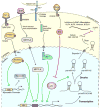Micromanaging vascular smooth muscle cell differentiation and phenotypic modulation
- PMID: 22011749
- PMCID: PMC4429757
- DOI: 10.1161/ATVBAHA.111.226670
Micromanaging vascular smooth muscle cell differentiation and phenotypic modulation
Abstract
The phenotype of vascular smooth muscle cells (VSMCs) is dynamically regulated in response to various stimuli. In a cellular process known as phenotype switching, VSMCs alternate between a contractile and synthetic phenotype state. Deregulation of phenotype switching is associated with vascular disorders such as atherosclerosis, restenosis after angioplasty, and pulmonary hypertension. An important role for microRNAs (miRNAs) in VSMC development and phenotype switching has recently been uncovered. Individual miRNAs are involved in promoting both contractile and synthetic VSMC phenotype. In this review, we summarize recent advances in the understanding of miRNA function in the regulation of VSMC phenotype regulation.
Figures


References
-
- Owens GK, Kumar MS, Wamhoff BR. Molecular regulation of vascular smooth muscle cell differentiation in development and disease. Physiol Rev. 2004;84:767–801. - PubMed
-
- ten Dijke P, Arthur HM. Extracellular control of TGFbeta signalling in vascular development and disease. Nat Rev Mol Cell Biol. 2007;8:857–869. - PubMed
-
- Tallquist M, Kazlauskas A. PDGF signaling in cells and mice. Cytokine Growth Factor Rev. 2004;15:205–213. - PubMed
-
- Kloosterman WP, Plasterk RH. The diverse functions of microRNAs in animal development and disease. Dev Cell. 2006;11:441–450. - PubMed
Publication types
MeSH terms
Substances
Grants and funding
LinkOut - more resources
Full Text Sources

